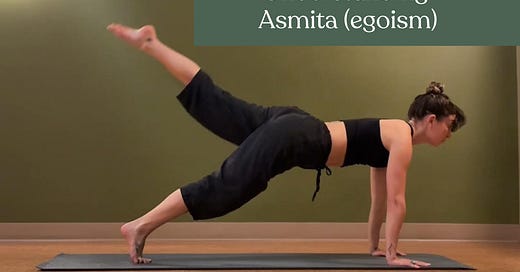Understanding Asmita (egoism) and how to teach it in class
// three flows to build an intermediate class toward Visvamitrasana
Dear Humans,
Sam Harris has a popular meditation app called Waking Up.
My husband purchased the course last year, and as he sat in the mornings to meditate, the rising sun gleaming through our eastern windows, I’d occasionally sit down next to him, close my eyes, and follow along.
Sam Harris, over and over, tells the meditator: “you are not your thoughts, you are the one watching.”
This isn’t something that Sam Harris coined, or created, or discovered. But when I think of how to describe the “ego” this is what I think of. It’s a simple and easy explanation for something which is deeply spiritual and complex.
It’s also a great way to explain the second of the Kleshas — Asmita.
The idea is this:
True awareness, or the true “self,” is what you can sense watching your thoughts pass through the mind. That awareness, the thing “watching,” is part of the collective spirit.
Everything else? Our thoughts? Our mind? All of our emotions? That’s the ego. That’s Asmita.
The idea is that we suffer because the ego has caused us to believe that the “false self” is the “true self.” In other words, we become attached to all of these experiences of the ego—our bodies, our worth, our productivity, etc.—while forgetting that those things don’t make us who we are. We are somewhere beyond that. Watching that. But we are not “that.”
This is one of those philosophical elements of the yoga practice that can be hard to wrap your mind around.
So how can you teach this in a yoga class?
To begin, when it comes to teaching yoga philosophy in class, I think the first barrier for us can sometimes be pronunciation. It’s helpful to know how to say the thing that you are trying to talk about. One tip is to go onto YouTube and take a look at how it’s pronounced in its mother language.
For Asmita, the pronunciation looks like “Ah-s-mee-ta.”
When I talked about this concept in my class, I began with a guided meditation. Centering breaths. Tuning into the present moment.
Then, taking a cue from Sam Harris (and others!), I invited students to notice the thoughts. After a little while, I then invited them to notice what was noticing the thoughts. To stay with that for a little while.
I asked them to reflect on the idea that we are not our thoughts, we are the ones watching the thoughts.
I reminded my students about the Kleshas, the veils which cause us to suffer (which we had covered in class before) and I explained that the second Klesha is Asmita or the ego.
In it’s very simplest definition, Asmita can be described in this way: “We suffer because we believe the false self is the self.”
Asmita reduces us to our thoughts, our emotions, to what we look like, what we can or cannot do, what we like and don’t like, our reputation, our failures—it causes us to think that’s who we are.
Asmita creates a sense of separation. We compare. We grow seeds of insecurity. We feel defensive. Or, we feel vindicated, prideful. But we forget that we are deeply connected.
So the opportunity presented to us in our yoga practice is to notice both the “watcher” and also notice what it’s watching—that’s Asmita. The opportunity is to notice the thoughts. Notice the stories. Try to quiet the mind. Attempt to tune into that true self.
That’s the practice. That’s the invitation.
There’s more you could say here, but I am a believer in starting small. Beginning with a seed of understanding. Let that sprout. Let that grow.
But do you have questions for me? More to add? Please let me know!
My friends, today I am sharing three sequences with you today. Honestly, I’m pretty excited about them. For everyone, I am sharing the mini-flow (though it’s pretty long!). It features a few fun transitions and prepares us for a Visvamitrasana variation in the Main Flow. This class was taught to an intermediate audience, so always be sure to modify it to meet your students.
I’m also sharing a COOL DOWN. I haven’t shared a bunch of cool downs with you, and that’s because I don’t always plan my cool down. But I’m going to try to share more of what I teach toward the end of my classes. I hope you enjoy!
Alright, that’s all for now. If I can swing it, then What I Read in Yoga This Month is also due to come out today. If you believe in me, I might be able to get it done. :) If not, you’ll get it very soon.
Last note: I planned our next live class! Mark your calendars for Monday May 12 at 5pm MT.
Okay, sending love, dear humans,
Izzy
Izzy Martens
author, yoga teacher, sequence enthusiast
www.yogahumans.com
Mark your calendar 📆
The next LIVE class for paid subscribers is coming up on Monday, May 12 at 5pm MT. You need the Substack App to join in live. The class will be a 45 minute vinyasa flow, featuring a sequence that I’ll share in this newsletter.
What I Taught in Yoga This Week | April 30, 2025
the write-up:
three legged dog
knee to nose
Keep reading with a 7-day free trial
Subscribe to What I Taught in Yoga This Week to keep reading this post and get 7 days of free access to the full post archives.






